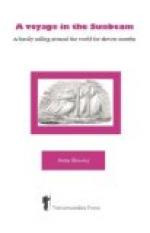Tuesday, October 10th.—In the early morning, when we resumed our voyage, the weather was still fine; but a few light clouds were here and there visible, and an icy wind, sweeping down from the mountains, made it appear very cold, though the thermometer—which averages, I think, 40 deg. to 50 deg. all the year round—was not really low. The line of perpetual snow commences here at an elevation of from 2,500 to 3,500 feet only, which adds greatly to the beauty of the scene; and as it is now early spring the snow is still unmelted, 500 feet, and even less, from the shore. The stupendous glaciers run right down into the sea, and immense masses of ice, sometimes larger than a ship, are continually breaking off, with a noise like thunder, and falling into the water, sending huge waves across to the opposite shore, and sometimes completely blocking up the channels. Some of these glaciers, composed entirely of blue and green ice and the purest snow, are fifteen and twenty miles in length. They are by far the finest we have, any of us, ever seen; and even those of Norway and Switzerland sink into comparative insignificance beside them. The mountains here are not so high as those of Europe, but they really appear more lofty, as their entire surface, from the water’s edge to the extreme summit, is clearly visible. At this end of the Straits they terminate in peaks, resembling Gothic spires, carved in the purest snow; truly ‘virgin peaks,’ on which the eye of man has but seldom rested, and which his foot has never touched. They are generally veiled in clouds of snow, mist, and driving rain, and it is quite the exception to see them as distinctly as we now do.
After leaving Mayne’s Channel, and passing through Union and Collingwood Sounds, we found ourselves beneath the shadow of the splendid Cordilleras of Sarmiento—quite distinct from Mount Sarmiento, already referred to—along the foot of which extended the largest glacier we have yet seen.[5] With Tarleton Pass on our right hand, and Childer’s Pass on the left, we came in sight of Owen’s Island, one extremity of which is called Mayne Head, and the other Cape Brassey, these places having all been so named by Captain Mayne, during his survey in the ‘Nassau,’ in 1869. Near the island of Esperanza, the clouds having by that time completely cleared away, and the sun shining brightly, we had a splendid view of another range of snowy mountains, with Stoke’s Monument towering high in their midst. The numerous floating icebergs added greatly to the exquisite beauty of the scene. Some loomed high as mountains, while others had melted into the most fanciful and fairy-like shapes—huge swans, full-rigged ships, schooners under full sail, and a hundred other fantastic forms and devices. The children were in ecstasies at the sight of them.
[Footnote 5: I should explain that the names of places in these Straits frequently occur in duplicate, and even triplicate, which is rather confusing.]




